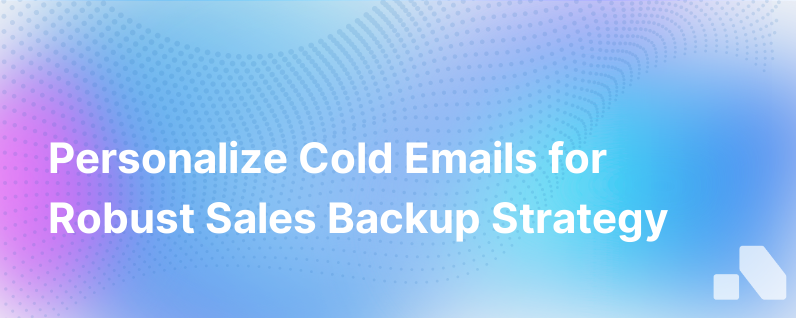Personalize Your Cold Email Build Backups
Published on January 7, 2024 by Sawyer Middeleer
In the vast ocean of digital communications, the humble cold email is often a life raft that startups can cling to, paddling their way towards the elusive island of 'gained customer.' It’s fascinating how even in an age replete with advanced communication tools, the simplicity of an email can break through the white noise of advertisements to establish a genuine connection with a potential client.
For B2B startups, the stakes are high: a single well-placed email might just lead to that game-changing partnership or sales deal. However, alongside its potential, the cold email can also be a double-edged sword, dismissed as spam if not executed with grace and strategy.
To prevent your outreach from vanishing in the blink of an eye, it’s imperative to personalize your cold email build. Doing so will nurture the seed of interest in your recipients and drastically increase the chances of conversion. In this guide, we’ll explore why personalization matters and how to create effective backups for your cold email templates.
The Essence of Personalization
Personalization is essential because it establishes relevance. In a data-driven world, generic messages are easily recognized as impersonal; when your email directly addresses the recipient's needs or interests, they’re more likely to engage. Research by Campaign Monitor suggests that emails with personalized subject lines are 26% more likely to be opened.
But there’s a nuance to personalization. It’s more than inserting a {First_Name} tag in your template. It's about crafting unique messages that resonate, which requires a deep understanding of the person and the business you are reaching out to.
Creating Personalized Templates
Building a great personalized cold email starts with detailed preparation. This includes meticulous research and segmentation of your target audience to create profiles that you can match to specific email templates.
For each segment, consider these factors:
- Industry Needs: What are the challenges and opportunities unique to their industry?
- Company Role: How does the recipient's role align with the service or product you offer?
- Company News: Has the company recently launched a product, raised rounds of capital, or expanded its team?
- Social Insights: Can you find insights from LinkedIn posts or tweets that provide a conversation starter?
Leveraging this information, you create targeted cold email templates for each segment. The templates should leave ample room for customization – think of it as creating a skeleton that will be fleshed out with personal details for every send out.
Building Backups
With templates in place, it's important to establish backups – these are alternate versions or parts of your email that can be used if a particular template isn’t getting the expected engagement. Here’s how to build effective backup options:
-
A/B Testing: Create variations of subjects and opening lines. Track their performance meticulously. The workload here can be alleviated by email marketing tools that often feature A/B testing as a standard function.
-
Content Variations: For each template, have different cortents primed for rotation. These could focus on various aspects of your proposition or different pain points of the target segment. Monitoring metrics like open rates, clicks, and replies will inform you which versions connect better.
-
Follow-up Sequences: Have a sequence in place if there’s no reply to your first email. Your sequence might include gentle reminders, additional value propositions, or information related to recent developments in the receiver’s industry.
-
Dynamic Fields: Utilize advanced dynamic fields that go beyond name and company. Include industry-specific details, references to recent events, or mutual connections.
-
Tech-driven Insights: Consider incorporating AI-powered platforms like Aomni – these tools analyze and optimize cold email effectiveness, automating much of the personalization and backup processes.
Leveraging Technology for Personalization
As your cold email campaigns increase in volume and complexity, technology becomes indispensable. Using intelligent platforms to manage and scale up personalization can reduce manual tasks, ensure consistency in communication, and provide actionable insights on what works.
Automation tools can segment lists meticulously, populate dynamic fields, send out emails at scale, and learn from the responses to improve over time. With every interaction, these tools help build a more detailed picture of what appeals to your prospects, tailoring future communications to be even more impactful.
The usage of tools like Aomni enhances your email campaigns by tapping into real-time data, ensuring relevance is maintained at the highest level. Such technology allows your messages to adapt more fluidly to your recipient’s current state, which in turn raises the value of your communication in their eyes.
Conclusion
Crafting a personalized cold email is both an art and a science. It demands a blend of emotional intelligence to tap into the psyche of your prospects, combined with the analytical rigor to distill engagement data into actionable insights. The buildup of effective backups and iterations is a testament to the iterative nature of cold email marketing – what doesn't work today could be the breakthrough of tomorrow.
In a world where the first touchpoint can make or break a potential deal, personalizing your cold email and having the right backups isn't just a recommendation but a necessity for B2B startups hungry for growth and success.